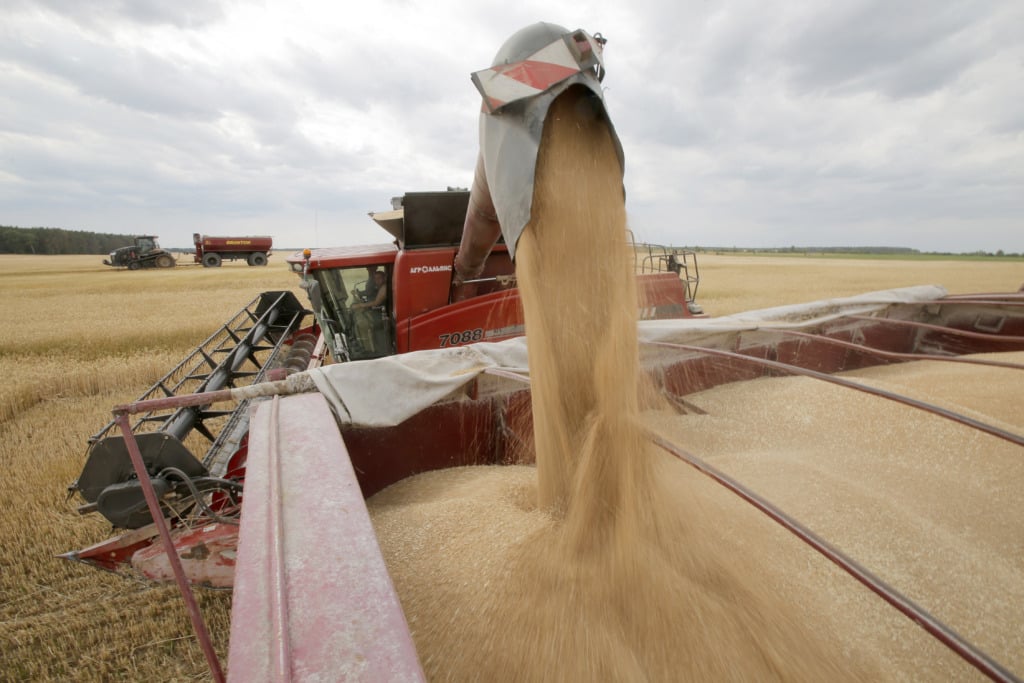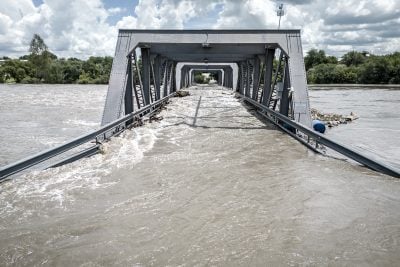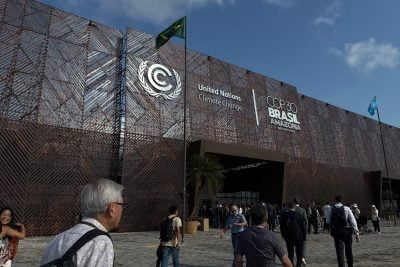Across vast expanses of Somalia, Ethiopia and Kenya, the bleached bones of an estimated 7m head of livestock crumble into the dust under the pitiless glare of the sun.
Emaciated cattle, sheep and goats, their angular ribcages visible through their ragged skins, search in vain for the water that will postpone their fate for another day. In Somalia alone, a third of the livestock are estimated to have perished.
The fourth rainy season in a row has failed, and there are fears that the fifth, scheduled to commence from October, will again disappoint. Meteorologists predict that the La Niña weather system, a contributor to the droughts, will continue until at least August and potentially into next year.
For hundreds of millions of people that live off the land across the East African region, the ongoing impact of the ceaseless drought is devastating.
“The most recent data I have is that there are 89m people in Eastern Africa alone that are acutely food insecure, so this is crisis levels and above. That represents almost 29% of the entire population of Eastern Africa… We’ve seen a really dramatic spike in the last few months – it’s effectively gone from 50m this time last year to 89m,” says Michael Dunford, regional director for Eastern Africa at the UN World Food Programme.
“There were already existing levels of vulnerability (from conflict) – add to that the effects of climate change and particularly the droughts taking place across Northern Kenya, Somalia, Southern Ethiopia, which are now spreading into Djibouti, the coastal region of Eritrea, and even now being felt in Uganda. We’re talking about the driest period in 40 years… This is the context in which we’re now feeling dramatic increases in costs – commodities, fuel, fertilisers, shipping. Some of this is driven by the war in Ukraine, but a lot was already in play, and we’re seeing it across the world.”
Increasing food prices
Terrifyingly, the historic droughts are just one in a series of factors that are coalescing to drive what many experts say could become the worst global food crisis since 2007-08. In Africa, the factors include the lingering supply chain impacts of Covid-19, the rising toll of climate change, and ongoing conflicts which feed displacement, including the devastating war in Ethiopia’s Tigray region.
As if that wasn’t enough for policymakers to contend with, Russia’s war on Ukraine has decimated one of the world’s key grain producing regions.
“The core of the crisis is coming from existing factors in the sense that we had food prices rising strongly since April last year as well as energy and fertiliser prices,” says David Laborde, senior research fellow in the markets, trade and institution division at the International Food Policy Research Institute.
“Starting last year, a number of economies in Asia reopened after lockdowns so we’ve had strong demand. At the same time we have this bottleneck in some value chains, and you have strong climatic events – Latin America is facing La Niña, there are dry and hot conditions in Western Europe, wheat production is down in Canada. You see strong demand, low supply, and inventories have been depleted. That’s important because when you have a new shock, like the invasion of Ukraine, if you have stocks, there’s a buffer. Right now we don’t have that buffer, so that’s the last drop that makes the bucket overflow.”
May’s FAO Food Price Index, a measure of the monthly change in international prices of a basket of food commodities, is 22.8% above its value in the corresponding month last year. The FAO Cereal Price Index is 29.7% above its May 2021 value. International wheat prices rose for a fourth consecutive month, up 5.6% in May to average 56.2% above their value last year and only 11% below the record high reached in March 2008.
In many parts of Africa, where households typically spend over half of their total income on food, the increase is particularly damaging – the IMF forecasts that consumer prices in sub-Saharan Africa will rise by 12.2% this year, the highest rate in almost two decades, putting basic commodities out of the reach of millions.
“If you look at the horizon, if the drought doesn’t end, if conflicts don’t end, if inflation doesn’t end, if the conflict in Ukraine doesn’t end, then there’s nothing to pull these numbers back,” warns Dunford.
“People talk about a perfect storm, and although it’s a bit of a cliché, I think it does give a good image to what is bearing down upon us.”
Impact of Ukraine war on food prices becomes clear
On 21 June, Ukraine’s President Volodymyr Zelensky was finally invited to address the African Union.
For much of the four months of brutal warfare his country has faced, African nations have adopted a neutral stance, maintaining relations with all sides in a bid to keep trade flowing. For many, that has meant the continuation of warm ties with Russia – the embattled Ukrainian president had to wait 10 weeks before being granted his request to address the AU.
In his speech, beamed into AU headquarters in Addis Ababa by videolink, Zelensky said that Africa can no longer ignore the impact of the invasion.
“Africa is actually a hostage… of those who unleashed war against our state,” Zelensky said. “This war may seem very distant to you and your countries. But the food prices that are catastrophically rising have already brought [the war] to the homes of millions of African families.”
While only four African heads of state attended Zelensky’s address – the rest sent representatives – the impacts are becoming clear. Firstly, the war has disrupted Ukrainian production, with planting and harvests abandoned as farmers and labourers flee war-threatened areas. Secondly, Russia has blockaded Ukraine’s Black Sea ports, the crucial gateway through which the region’s produce reaches global markets. Lastly, although fertiliser itself is not subject to sanctions, sanctions on Russia and its ally Belarus, both major producers, have complicated its route to African markets and increased prices.
African food production will be hit
“We are very worried for a couple of reasons,” says Martin Fregene, director of agriculture and agro-industry at the African Development Bank.
“Number one, Africa has become used to cheap grain coming from Russia, Ukraine and other parts of the world. With the war in Ukraine there has been disruption in at least 30m tonnes of supply of wheat, maize and oil seeds to Africa. Second is that Russia is one of the largest exporters of blended fertiliser. And right now Africa is missing 2m tonnes of fertiliser because of the war in Ukraine and sanctions against Russia and Belarus. There’s a reduced supply which means farmers are not going to be able to apply as much fertiliser, which is so important for crop yields.
“You’re looking at a 20-40% decrease in local production of cereals, anywhere from 20-30m tonnes, and the continent already had a shortfall of 50-60m tonnes. And farmers themselves are facing difficulties, because the price of fertiliser has tripled in two years and they do not have elastic budgets. When the new harvest comes in October, a new shortfall in production due to a lack of fertiliser and grains not coming from Ukraine will create a perfect storm.”

North Africa particularly exposed to grain shortages
North Africa, long a major importer of grains from the Black Sea, is particularly exposed to shortages.
“For North African countries down to Sudan, the Black Sea is their grocery shop,” says IFPRI’s Laborde. “It’s next door, they can buy wheat, maize for the poultry sector and sunflower oil. Reopening the Black Sea is going to be important to make sure they can source from Ukraine, but also costs with Russia would be lower… Bringing peace has a lot of dividends for them.”
Wealthier North African countries like Egypt, says Laborde, may be able to bear those costs for a while. But nearby Sudan, wracked by drought and political strife, is facing a reckoning. According to IFPRI research, only about 15% of the wheat consumed in Sudan is grown there, with between 2 and 2.5m tonnes imported from Russia and Ukraine individually in 2020 alone.
Their model indicates that disruptions in the world wheat market due to the Ukraine war have had a major impact on Sudan’s wheat market, though about half the magnitude of the adverse domestic shock of July 2021-February 2022.
Rising food costs could spark political strife
As well as weighing heavily on countries that import directly from the Black Sea, the war also has significant inflationary effects on the price of food imported from other regions. Dunford says the WFP last year procured 740,000 tonnes of commodities from the Black Sea region for distribution in Eastern Africa, amounting to around $250m.
This year, the WFP is having to procure supplies from further afield, pushing up the costs of fuel and transportation. Dunford estimates that annual funding requirements have increased from $4.5bn to $5.6bn in the region, including an estimated $27m extra per month because of increased commodity, fuel and transportion costs. Dunford says that there is enough food supply globally, but rising costs could spark political strife and fuel conflict in the most vulnerable nations.
“At the moment it’s primarily [a problem of] access – the ability of people to access commodities with their incomes,” says Dunford. “What I think we’ll increasingly see is an availability challenge where it will become too expensive, or because of a lack of fertiliser people won’t be able to grow the harvests they have in the past. Today, globally there is sufficient food despite the challenges in Ukraine and the Black Sea. But costs are rising fast… Anything that gives not only the WFP but world markets access to commodities in the Black Sea will ease the pressure.”
Diplomatic efforts are underway – Turkey has been trying to negotiate the terms of an escort for more than 20m tonnes of Ukrainian grain, and the UK says it supports a mooted international plan to protect commercial shipping in the Black Sea.
But Laborde cautions that a resolution of the war alone will not solve the crisis.
“We still have enough food globally, the question is price and affordability. There is enough food but not enough money in Africa to buy it. A Black Sea solution would accelerate the recovery, but it’s not going to be an incredible gamechanger because if we open Ukrainian ports, production is in any case down by 40%. You may have ports open but nothing to trade. Some of the damage of the next six months has already been done.”
What is to be done?
With so many contributory factors at play, policymakers face a complex set of choices.
Dunford cautions against protectionist measures which could further distort the market – in May, India announced that it would ban wheat exports after unseasonably hot weather.
“It’s very important they don’t take any negative measures that impact supply chains across the region. Some countries have implemented or talked about export bans – that’s a stopgap measure that is not going to address regional needs. Keeping trade flowing will minimise the risks of further disruption and speculation.”
The multilateral system is also kicking into gear. On 21 June, the World Bank Group approved a $2.3bn programme to help countries in Eastern and Southern Africa, including strengthening early warning systems and rapid response planning, emergency support to producers, emergency trade measures, and boosting emergency food reserves. It approved a similar plan for West and Central Africa last year.
The African Development Bank has launched an African Emergency Food Production Facility to provide 20m African smallholder farmers with seeds and access to fertilisers in a bid to enable them to rapidly produce 38m tonnes of food – a $12bn increase in production in two years. Fregene says the programme will provide direct subsidies to farmers to buy fertiliser and other inputs, as well financing large importers of fertiliser to source supply from other regions.
The facility is designed to be spread over four seasons, beginning with the current major season in the northern hemisphere and the minor season in the southern hemisphere.
“We should see some major changes in production beginning in March/April next year,” he says.
Fregene says that in-country platforms uniting governments, banks, the private sector, and development partners will be at the heart of the plan, and is encouraged by apparent success in Ethiopia.
About 600,000 additional hectares of wheat were planted in the country in 2022, and the agriculture ministry says it expects 2.4m tonnes of wheat to be harvested this year, compared with 1.42m in 2021, despite warnings from the US that a target to stop imports next year is “very unrealistic”.
Short-term support is needed
But with several months until the results become clear, short-term support will also be essential. Fregene says that policymakers should consider cash transfers to vulnerable populations to help them to navigate higher prices. Laborde says that as well as tapping traditional donors, African countries less impacted by the crisis should consider extending support to more impacted neighbours.
“There’s an opportunity to see African solidarity because the price of oil and energy is very high – if you’re in Algeria or Tunisia you’re in two very different situations – the former is making money this year. There’s an opportunity to ground solutions within the continent.”
But with the crisis likely to drag on until 2023, the costs of emergency measures are likely be substantial, he predicts.
“We have a very complex situation in fertiliser markets and that will impact the next harvest and a large part of 2023. In order to rebalance supplies we need to increase supply in other places, but if you are a farmer you cannot increase supply in the middle of the season. Even next year we’ll see high prices. They will start to go down step by step and with a new wave of production will start to go down, but not back to where they were last year in Africa… Right now we’re on track to stabilisation and recovery over 18 months.”
Africa cannot rely on others for food security
But the real goal must be to make sure that Africa is better placed to deal with the range of exogenous shocks that are facing it in the future.
While climate-induced shocks to the food system used to occur once every 10 years on average, they are now occurring every 2.5 years, according to Boutheina Guermazi, World Bank director of regional integration for Africa, the Middle East and North Africa.
“Even once this drought is over, because of climate change, changes in weather patterns, the next one is probably only four to five years away,” says Dunford. “It’s a very short window for the investments to be made to build up resilience… I do feel this will be a dramatic wakeup call. The trouble is that it will come at significant costs to those who can least afford it.”
Laborde and Fregene agree.
“At the continental level you have the Malabo Declaration where countries should have spent 10% of their budget on agriculture – very few have done it. The situation is complex but at the same time policymakers are paying the price for what they have not done. We are going to go through the crisis and then people will forget again about agriculture. That’s why we need to articulate a medium- and long-term response,” says Laborde.
“People say never let a crisis go to waste,” says Fregene. “The Ukraine war is luckily showing us we cannot rely on others for food security. You don’t have to wait until the house is on fire… This is the time right now to invest in those areas that will strengthen agriculture.”
Want to continue reading? Subscribe today.
You've read all your free articles for this month! Subscribe now to enjoy full access to our content.
Digital Monthly
£8.00 / month
Receive full unlimited access to our articles, opinions, podcasts and more.
Digital Yearly
£70.00 / year
Our best value offer - save £26 and gain access to all of our digital content for an entire year!
 Sign in with Google
Sign in with Google 



